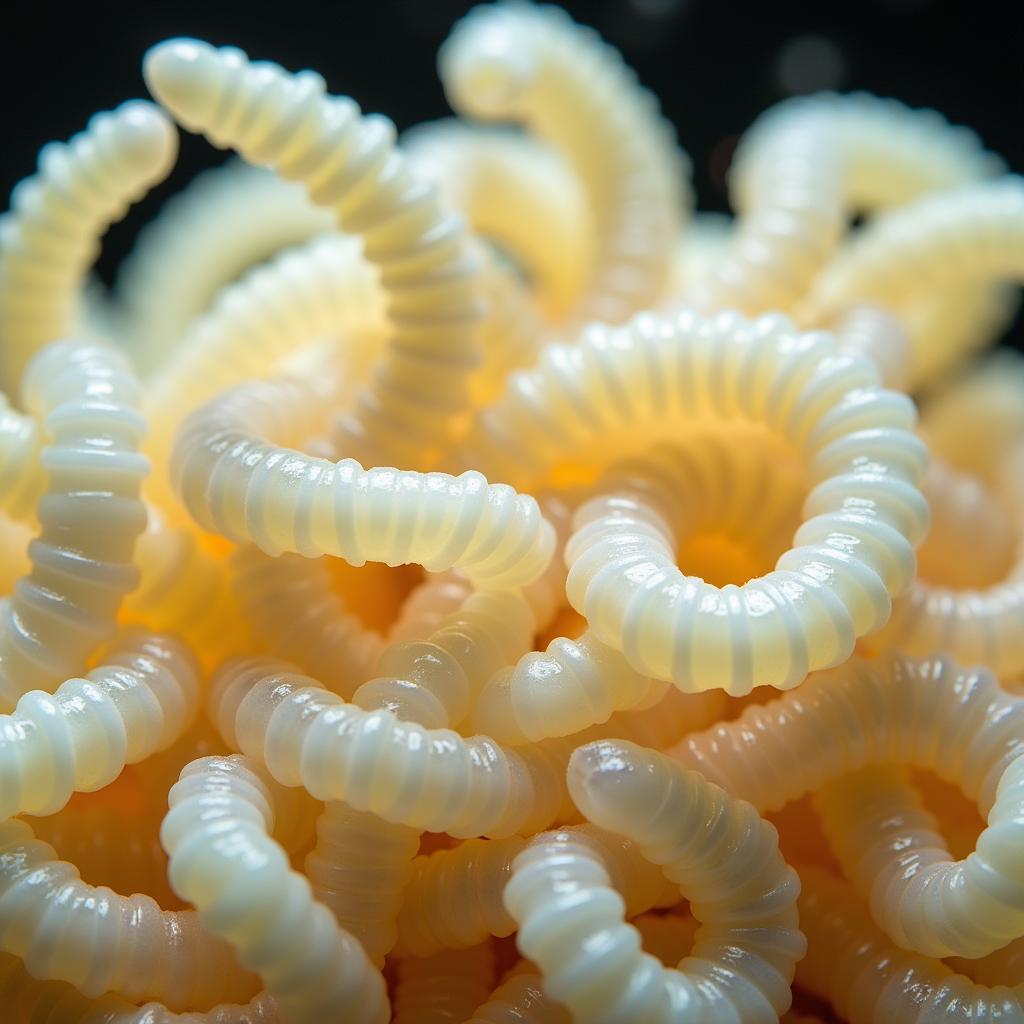White worms are a popular live food option for many aquarium fish, offering a nutritional boost and stimulating their natural hunting instincts. They are a good source of protein and other essential nutrients, making them a valuable addition to a balanced fish diet. Choosing the right white worms and understanding how to feed them properly is crucial for the health and well-being of your aquatic pets. Let’s dive into the world of white worms as fish food. You can find more information about other live food options at live food for fish.
What are White Worms and Why Use Them as Fish Food?
White worms, often referred to as Enchytraeus albidus, are small, segmented worms that thrive in moist environments. They are relatively easy to culture at home, making them a readily available and cost-effective live food source for fish keepers. Their wriggling movement attracts even the most picky eaters, encouraging a healthy appetite and adding enrichment to the tank environment. White worms are especially beneficial for smaller fish or fry, providing a protein-rich food source that promotes rapid growth. For more on feeding discus fish, check out this resource on discus fish food.
Nutritional Benefits of White Worms
White worms are packed with nutrients essential for fish health, including:
- Protein: Crucial for muscle development and overall growth.
- Fat: Provides energy and supports healthy cell function.
- Fiber: Aids in digestion.
- Vitamins and minerals: Contribute to various metabolic processes and overall well-being.
Why Choose White Worms over Other Live Foods?
White worms offer several advantages over other live food options:
- Ease of Culture: Relatively simple to breed and maintain at home.
- Nutritional Value: High in protein and other essential nutrients.
- Palatability: Their movement stimulates the natural feeding instincts of fish.
- Size: Ideal for smaller fish and fry.
 White worms close-up view for fish food
White worms close-up view for fish food
How to Culture White Worms at Home
Culturing white worms at home is a straightforward process:
- Prepare the Culture Medium: A mixture of moist oatmeal, bread crumbs, and milk provides a suitable environment for the worms to thrive.
- Introduce the Starter Culture: Purchase a starter culture of white worms from a reputable supplier or pet store.
- Maintain Optimal Conditions: Keep the culture in a dark, cool place with consistent moisture levels.
- Harvest Regularly: Remove a portion of the culture for feeding and replenish the medium as needed.
Feeding White Worms to Your Fish
While white worms are a nutritious food source, it’s crucial to feed them in moderation. Overfeeding can lead to water quality issues and potential digestive problems for your fish.
How Much and How Often to Feed
- Frequency: Offer white worms as a supplemental food 2-3 times a week.
- Quantity: Feed only what your fish can consume within a few minutes.
Tips for Safe Feeding
- Rinse Thoroughly: Rinse the worms before feeding to remove any excess culture medium.
- Vary the Diet: Don’t rely solely on white worms. Offer a variety of foods to ensure a balanced diet.
- Observe Your Fish: Monitor your fish for any signs of digestive upset or changes in behavior.
Remember, a diverse diet is essential for optimal fish health. Explore other live food options such as those available at live fish food for sale.
Common Concerns About White Worms
Some aquarists express concerns about the potential for white worms to overpopulate the tank or carry diseases. However, with proper management, these risks can be minimized.
Overpopulation
- Controlled Feeding: Feed only the amount your fish can consume, preventing excess worms from establishing themselves in the substrate.
- Regular Cleaning: Regular gravel vacuuming and water changes help prevent any uneaten worms from multiplying in the tank.
Disease
- Reputable Sources: Obtain your starter culture from a trusted supplier to minimize the risk of introducing parasites or diseases.
- Quarantine: Consider quarantining new fish before introducing them to the main tank to prevent the spread of any potential pathogens.
If you’re concerned about pests in your other pet’s food, you might find this article helpful: worm in dog food.
Conclusion
White worms are a valuable and nutritious live food option for aquarium fish, offering a stimulating feeding experience and a boost of essential nutrients. By understanding how to culture and feed white worms properly, you can provide your aquatic pets with a healthy and enriching dietary supplement. Remember to feed in moderation, maintain good tank hygiene, and source your cultures responsibly to ensure the well-being of your fish.
FAQ
- Are white worms suitable for all types of fish? While many fish enjoy white worms, some species may not be interested or have specific dietary requirements.
- Can white worms overpopulate my aquarium? Overpopulation can be prevented by controlled feeding and regular tank maintenance.
- How long can I store cultured white worms? Properly stored cultures can last for several weeks.
- What are the signs of overfeeding white worms? Uneaten worms in the substrate, cloudy water, and changes in fish behavior can indicate overfeeding.
- Where can I buy a starter culture of white worms? Reputable pet stores and online suppliers offer starter cultures.
- Are there any alternatives to white worms as live food? Yes, there are other live food options such as bloodworms, daphnia, and brine shrimp.
- Can I feed white worms to my fish fry? Yes, white worms are an excellent food source for fry due to their small size and nutritional content.
Need some fun food ideas for a party? Check out food ideas for toy story party.
Need assistance with your white worm fish food journey? Contact us at Phone Number: 02437655121, Email: minacones@gmail.com Or visit us at: 3PGH+8R9, ĐT70A, thôn Trung, Bắc Từ Liêm, Hà Nội, Việt Nam. We have a 24/7 customer service team.